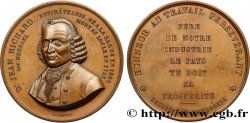fme_786178 - SWITZERLAND Médaille pour les 300 ans de la Réforme
40.00 €(Approx. 47.20$ | 34.80£)
Quantity
Add to your cart

Type : Médaille pour les 300 ans de la Réforme
Date: 1835
Mint name / Town : Suisse, Genève
Metal : bronze
Diameter : 39 et 34,5 sans la bélière mm
Orientation dies : 12 h.
Engraver SCHLÜTTER
Weight : 21,20 g.
Edge : lisse
Puncheon : sans poinçon
Coments on the condition:
Jolie patine marron avec une petite usure sur certains reliefs. Présence de quelques coups et rayures. La médaille est cerclée d’une monture en cuivre avec bélière
Obverse
Obverse legend : POST TENEBRAS LUX.
Obverse description : Bible ouverte.
Reverse
Reverse legend : 3E JUBILÉ / DE LA / RÉFORMATION / GENÈVE / 25 AOÛT / 1835.
Reverse description : Légende en 6 lignes horizontales.
Commentary
Diamètre sans bélière (mais avec la monture) : 34,5 mm
La réforme protestante, également appelée « la Réforme », amorcée au XVIe siècle, est une volonté d'un retour aux sources du christianisme et aussi, par extension, un besoin de considérer la religion et la vie sociale d'une autre manière. Elle reflète l'angoisse des âmes, par la question du salut, centrale dans la réflexion des réformateurs, qui dénoncent la corruption de toute la société engendrée par le commerce des indulgences. Les réformateurs profitent de l'essor de l'imprimerie pour faire circuler la Bible en langues vulgaires (notamment l'allemand après la première traduction réalisée par Martin Luther), et montrent qu'elle ne fait mention ni des saints, ni du culte de la Vierge, ni du Purgatoire. La référence à la Bible comme norme est une des principales motivations des réformateurs..
Diameter without bail (but with the mount): 34.5 mm The Protestant Reformation, also called \\\"the Reformation\\\", which began in the 16th century, is a desire for a return to the sources of Christianity and also, by extension, a need to consider religion and social life in a different way. It reflects the anguish of souls, through the question of salvation, central to the reflection of the reformers, who denounce the corruption of all society engendered by the trade in indulgences. The reformers took advantage of the rise of printing to circulate the Bible in vernacular languages (notably German after the first translation by Martin Luther), and show that it makes no mention of saints, the cult of the Virgin, or Purgatory. The reference to the Bible as a standard is one of the main motivations of the reformers.
La réforme protestante, également appelée « la Réforme », amorcée au XVIe siècle, est une volonté d'un retour aux sources du christianisme et aussi, par extension, un besoin de considérer la religion et la vie sociale d'une autre manière. Elle reflète l'angoisse des âmes, par la question du salut, centrale dans la réflexion des réformateurs, qui dénoncent la corruption de toute la société engendrée par le commerce des indulgences. Les réformateurs profitent de l'essor de l'imprimerie pour faire circuler la Bible en langues vulgaires (notamment l'allemand après la première traduction réalisée par Martin Luther), et montrent qu'elle ne fait mention ni des saints, ni du culte de la Vierge, ni du Purgatoire. La référence à la Bible comme norme est une des principales motivations des réformateurs..
Diameter without bail (but with the mount): 34.5 mm The Protestant Reformation, also called \\\"the Reformation\\\", which began in the 16th century, is a desire for a return to the sources of Christianity and also, by extension, a need to consider religion and social life in a different way. It reflects the anguish of souls, through the question of salvation, central to the reflection of the reformers, who denounce the corruption of all society engendered by the trade in indulgences. The reformers took advantage of the rise of printing to circulate the Bible in vernacular languages (notably German after the first translation by Martin Luther), and show that it makes no mention of saints, the cult of the Virgin, or Purgatory. The reference to the Bible as a standard is one of the main motivations of the reformers.








 Report a mistake
Report a mistake Print the page
Print the page Share my selection
Share my selection Ask a question
Ask a question Consign / sell
Consign / sell
 Full data
Full data










